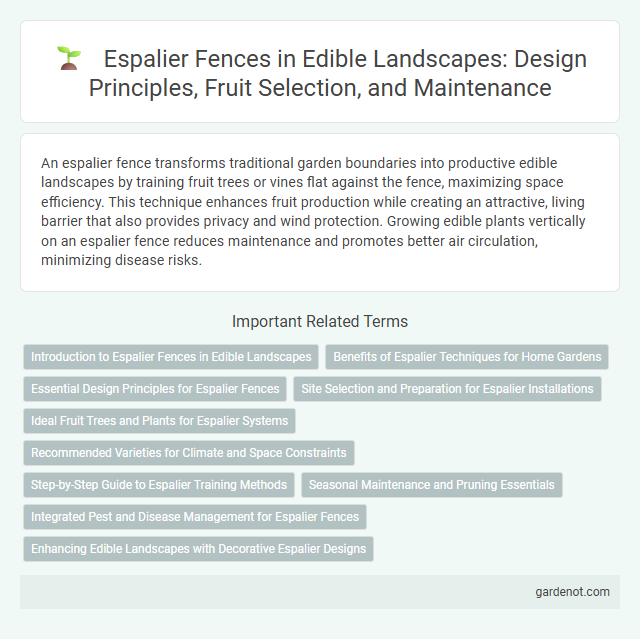An espalier fence transforms traditional garden boundaries into productive edible landscapes by training fruit trees or vines flat against the fence, maximizing space efficiency. This technique enhances fruit production while creating an attractive, living barrier that also provides privacy and wind protection. Growing edible plants vertically on an espalier fence reduces maintenance and promotes better air circulation, minimizing disease risks.
Introduction to Espalier Fences in Edible Landscapes
Espalier fences transform vertical garden spaces by training fruit trees or vines to grow flat against a framework, maximizing edible yields in limited areas. This technique enhances sunlight exposure and air circulation, promoting healthier growth and easier harvesting of fruits like apples, pears, and grapes. Incorporating espalier fences into edible landscapes creates a visually striking, productive boundary that blends function with aesthetic appeal.
Benefits of Espalier Techniques for Home Gardens
Espalier techniques maximize limited garden space by training fruit trees along fences, creating efficient vertical growth that increases fruit yield per square foot. This method improves air circulation and sunlight exposure, reducing disease risk and enhancing overall plant health. Incorporating espalier fences in home gardens also offers an aesthetically pleasing, productive barrier that combines functionality with visual appeal.
Essential Design Principles for Espalier Fences
Espalier fences require careful attention to plant selection, favoring species such as apple, pear, or fig that respond well to pruning and training. Proper spacing between plants ensures adequate airflow and light penetration, reducing disease risks and promoting healthy growth. Consistent pruning techniques shape the plants into flat, two-dimensional forms, maximizing fruit production and enhancing the aesthetic appeal of the edible landscape.
Site Selection and Preparation for Espalier Installations
Selecting a site for espalier installations requires choosing a location with ample sunlight, typically 6-8 hours daily, and well-drained soil to promote healthy growth. Preparing the site involves clearing debris, loosening the soil to enhance root penetration, and amending it with organic matter such as compost to improve fertility and moisture retention. Installing sturdy support structures like trellises or fences aligned to the desired espalier pattern ensures proper training and maintenance of fruit trees or vines.
Ideal Fruit Trees and Plants for Espalier Systems
Ideal fruit trees for espalier fences include apple, pear, and fig varieties, known for their flexible branches and ability to thrive when trained against a support structure. Plants such as peaches, plums, and apricots also respond well to espalier techniques, producing abundant fruit while optimizing limited garden space. Selecting disease-resistant cultivars and dwarf rootstocks enhances growth control and fruit production in espalier systems.
Recommended Varieties for Climate and Space Constraints
Espalier fences thrive with dwarf or semi-dwarf fruit tree varieties such as 'Compact Stella' cherry, 'Pixie Crunch' apple, and 'Bonica' plum, which are ideal for limited space and temperate climates. These cultivars adapt well to pruning and training, ensuring manageable growth and optimal fruit production in confined urban gardens or small backyards. Selecting climate-appropriate varieties enhances disease resistance and yield, making espalier fences both functional and aesthetically pleasing in edible landscapes.
Step-by-Step Guide to Espalier Training Methods
Espalier training transforms fences into productive edible landscapes by guiding fruit trees to grow flat against the structure, enhancing space and yield. Begin by selecting suitable tree varieties like apples or pears, prune initial growth to establish a central leader, then tie flexible branches horizontally along the fence using soft ties to encourage linear growth. Maintain consistent pruning each season to remove vertical shoots and reinforce horizontal growth, maximizing sunlight exposure and fruit development on the espalier fence.
Seasonal Maintenance and Pruning Essentials
Espalier fences require precise seasonal maintenance to promote healthy growth and maximize fruit production throughout the year. Pruning essentials include removing dead or diseased branches during late winter and thinning shoots in early spring to improve air circulation and sunlight exposure. Proper pruning techniques enhance the structural integrity of the espalier, ensuring a productive and visually appealing edible landscape.
Integrated Pest and Disease Management for Espalier Fences
Integrated Pest and Disease Management (IPDM) for espalier fences involves monitoring for common pests such as aphids, spider mites, and scale insects that thrive on espaliered fruit trees. Employing biological controls like ladybugs and predatory mites helps reduce pest populations while minimizing chemical use. Proper pruning and sanitation practices prevent disease spread by improving air circulation and removing infected plant material.
Enhancing Edible Landscapes with Decorative Espalier Designs
Espalier fences transform edible landscapes by combining functional fencing with artistic fruit tree training techniques, optimizing space for vegetable and herb growth. These decorative designs improve air circulation and sunlight exposure, boosting plant health and fruit yield while creating visually appealing garden boundaries. Incorporating espaliered apple, pear, or fig trees into fences maximizes productivity in small urban gardens and sustainable foodscaping projects.
Espalier fence Infographic

 gardenot.com
gardenot.com